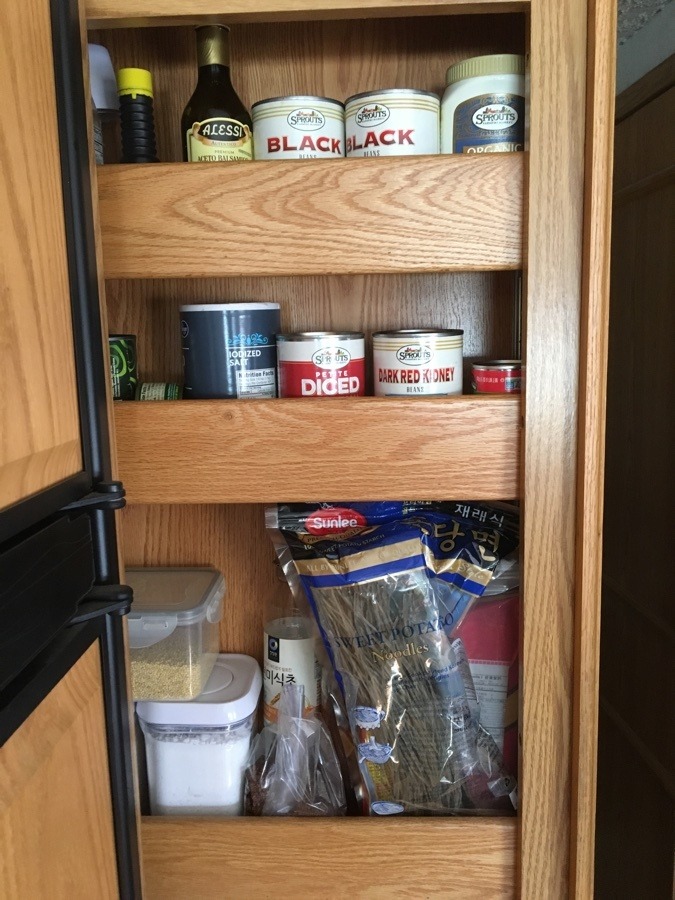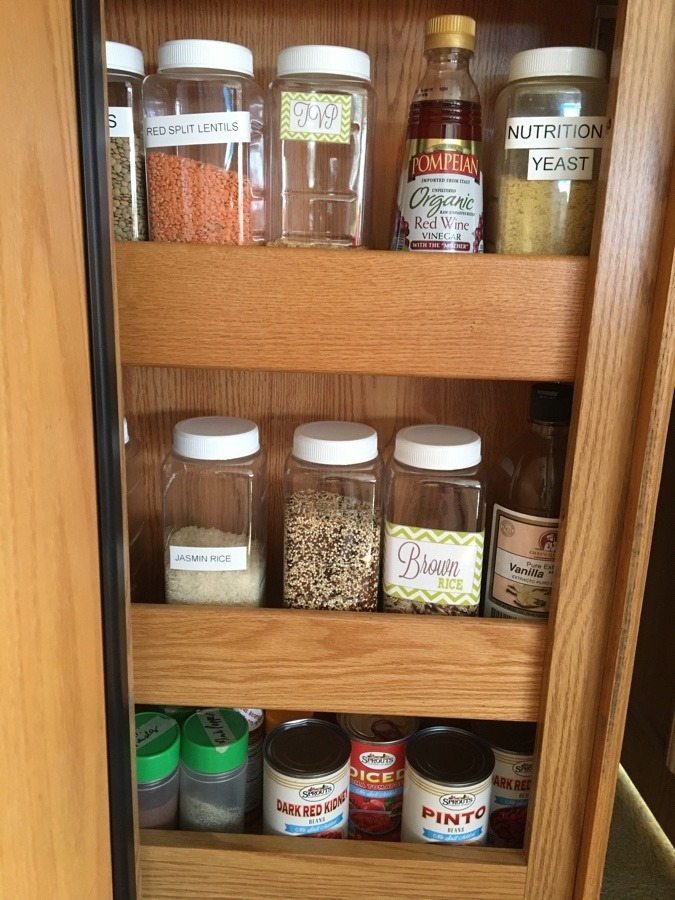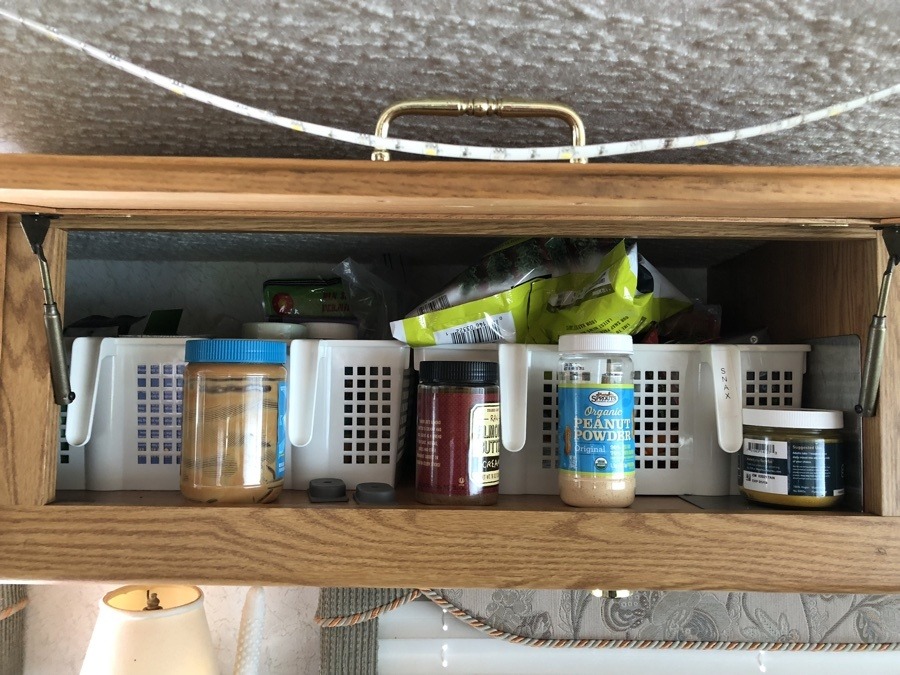Pantry Staples in our Vegan RV Kitchen
You might have noticed that RV kitchens are not known for having tons of storage. Even a large Class A motorhome is limited compared to a sticks and bricks kitchen. So what do we consider our RV pantry staples given the limited space?

I’m going to go through our must-haves here, but as with anything in the RV, it’s an ever-evolving list. We made significant changes after my health scare and now just about everything we carry is whole food plant-based.
If you read Dr. Greger’s How Not To Die you’ll find the in-depth reasoning behind many of the items we keep on hand. I’ll mention benefits with some of these items but not every single thing. I highly recommend you read that book for evidence-based recommendations.
I’ve separated the RV pantry staples into categories that made sense to me: Grains & Pasta, Nuts & Seeds, Flavorings, Beverages, Dried Proteins, and Canned Goods. Maybe they’ll make sense to you too; maybe they won’t.
You’ll notice a theme – quick-cooking. The faster something cooks, the less moisture, and odor will be released into the RV. You also want to keep stove and oven use to a minimum when the temperatures start to rise.
Note: I’ve provided Amazon links to some of these items. Most of them are the more unusual things you might not recognize. These are affiliate links so if you buy through them we will get a small commission but the item costs the same to you whether you use our link or not.
The refrigerator and freezer items are a little more fluid. I’ll have to do another post on produce, condiments, and frozen things we usually keep on hand.
Some notes about RV pantry staples storage
The squared off spice bottles in the drawer, and the tall square containers in the pantry came from Aaron Packaging. You can buy small quantities. I didn’t want to waste space with round containers. I love these, and they’ve held up great so far.

In the upper cabinets, we have plastic bins with handles so we can quickly pull them out and grab what’s inside. We also use these in the fridge. Ours came from the Container Store but if you’re lucky you can find them at a dollar store.

Excess from bulk packages of oats, chia seeds, almond milk, etc. is stored under the dinette seat or shoved under the dinette towards the wall.
Our RV Pantry Staples
Grains & Pasta
Oats
We have oatmeal or overnight oats every morning for breakfast. Oats are also a main ingredient in my Indian Lentil Burgers. They are a cheap whole grain that is quick to prepare. We usually get giant bags of old-fashioned oats at Costco, but sometimes we get steel-cut oats. Pro-tip: Steel cut oats can also make overnight oats! Also, avoid those little instant packets. They’re usually full of added sugars.
More importantly, oats are crazy healthy! Oats are loaded with soluble fiber, can help lower LDL (bad) cholesterol, and has a low glycemic index and can help lower blood sugar.
Rice
Brown rice, red rice, wild rice, black rice, or a combination of all of these – it’s our primary whole grain staple. If you hit a store that has bulk bins, you can make your own blend. Whole grain rice takes 22 minutes active cooking time in the Instant Pot which translates to about 35-40 minutes total time. I make it in big batches that we will eat all week, sometimes freezing a bit of it if we won’t use it up fast enough.
Quinoa
Quinoa is a seed, but you use it as a grain. It only takes 15 minutes to cook on the stove-top. We usually keep a blend of white, red, and black quinoa on hand. We use like rice or toss a little bit on whole meal salads. Its claim to fame is that quinoa is an excellent source of protein.
Millet
Millet is a quick-cooking whole grain that we keep on hand as an occasional alternative to quinoa and rice. Its mild flavor makes it suitable to use in place of either.
Pasta
I’ve filed pasta under grains because we only buy whole grain or bean pasta. Also, I had nowhere else for it to go. Whole grain pasta is easy to find at just about any grocery store. We were lucky enough to find this edamame pasta at Costco, and we’ve been eating off of it for months.
Nuts & Seeds

Instead of using oils we get our fats from nuts and seeds. You can make satisfying sauces and dressings from nuts like cashews and almonds. We buy all of these raw.
Walnuts
Walnuts have many benefits including omega 3s, antioxidants, and they can improve artery health. We eat about two tablespoons every morning on our oats.
Almonds
With raw almonds, you can make your own almond milk, and we sometimes do. No, you don’t need a Vitamix. Our Nutribullet does the job just fine. They’re also an ingredient in some heartier dressing and sauce recipes.
Brazil Nuts
Brazil nuts are loaded with selenium which can be hard to get by other means, So packed that you don’t want to eat too many brazil nuts. They’ve been shown to reduce inflammation and raise HDL (g0od) cholesterol among other benefits. I usually eat about three nuts per week. A small amount of the bulk bin, I’ve found them at Sprouts, will last you quite a long time.

Pumpkin Seeds
Pumpkin seeds are an excellent source of trace minerals such as magnesium and zinc and make a delicious salad topping.
Hemp Seeds or Hearts
Hemp seeds have omega 3s and omega 6s in a 3:1 ratio which is ideal. We like them sprinkled on salads and occasionally in our morning oats.
Chia Seeds
We use chia seeds in our overnight oats. You can also use them to replace eggs in baked goods. Mix one tablespoon of chia seeds with 2 1/2 tablespoons of water and let sit for a few minutes to replace one egg. Chia seeds are high in omega 3s, antioxidants, protein, and fiber.
Flax Seeds
Flax seeds are also high in omega 3s and are my favorite egg replacer for baked goods. One tablespoon of ground flax seeds plus three tablespoons of warm water equals one egg. We put ground flax seeds in our morning oats daily.
Sesame Seeds
Sesame seeds are a tasty addition to salads, stir-fries, and Asian-style dishes. Toast them lightly in a dry pan to bring out their flavor.
Flavorings
Nutritional Yeast
Nutritional yeast has a cheesy flavor and is a component of many vegan cheese sauces. We also like to sprinkle it on sweet potatoes and pasta in red sauce. It’s a rare vegan food that contains B12 as well.
Tahini
Tahini is an ingredient in a few sauce and salad dressing recipes that we use. It’s just ground up sesame seeds.
Vanilla Extract
We use vanilla in our overnight oats and when we make almond milk. It gives sweetness without adding actual sugar.
Almond Butter
I use almond butter for sandwiches. It’s also in a quick pasta sauce recipe from the How Not to Die Cookbook. And you can make quick dressings for salads and bowls from it. We’ve found the best price at Sprouts and Trader Joe’s.
Peanut Butter
Kevin uses peanut butter. He only eats the kind with sugar in it, so I don’t eat it.
Spices
The spices you need will depend on your cooking style. We make all kinds of different cuisines, so we probably carry more spices than most people. Some of our most used spices are turmeric, cinnamon, paprika, smoked paprika, garlic powder, red pepper flakes, cayenne, oregano, basil, thyme, cumin, parsley, curry powder, chili powder, bay leaves, salt, and pepper.
Vinegar
We keep a few kinds of vinegar on hand mostly for salad dressings, but they are sometimes used in sauces and soups too. Right now we have Balsamic Vinegar, Rice Vinegar, Apple Cider Vinegar, and Red Wine Vinegar. I’ll probably add a fancy fruit-infused vinegar to this list when I find one that appeals to me.
Canned Goods
Tomato Paste
Tomato paste shows up in many sauces and soups. Since many recipes only call for one or two tablespoons, I keep the rest of the can in a container in the freezer.
Beans
We have more cabinet storage than refrigerator and freezer storage. So while I love making my own beans from dried, canned beans are easier for us to keep. Black beans, pinto beans, and chickpeas are easy to find canned without salt. Dr. Greger recommends three servings of beans daily and having handy beans helps make that happen.
Diced Tomatoes
Fresh and cooked tomatoes each have different health benefits. Canned salt-free diced tomatoes can become a quick red sauce for pasta or you can use them as a component of chili, soups, stews, and more. I used it at least once a week if not more.
Dried Proteins
Lentils
Lentils are quick cooking beans that don’t require pre-soaking. Brown, green, and black lentils stay whole when cooked. Red lentils break down and are perfect for making a soup thick and hearty like our Red Lentil Soup, but they might not be easy to find in some more rural areas.
Soy Curls
Butler’s Soy Curls have one ingredient – non-GMO soy. They come in little chicken-like strips. Soy curls are simple to rehydrate and then flavor as you will. Here are a few recipes to get you started. So far we’ve only seen these once in a store, but you can get them from Amazon.
TVP
TVP is also just soy but in smaller ground-beef size crumbles. We like to add it to chili. You can also make your own flavored crumbles with it like chorizo, sausage, or pepperoni.
Beverages
Unsweetened Vanilla Almond Milk
Costco has 6-packs of shelf-stable unsweetened vanilla almond milk that we pick up whenever we go. I use it in my coffee, and we use it in our overnight oats. Occasionally Kevin will drink it. This one and Almond Breeze seem to be the ones with the fewest additives.
Tea
We have a few different teas on hand at any given time with and without caffeine. Ginger-turmeric and jasmine green tea are a couple of favorites.
Coffee
We haul around a burr grinder, coffee maker, and aero press, so we never have to be without a high-quality coffee. Now that the solar is set up we can run the coffee pot whenever we want. We usually choose a dark roast, organic, and local when possible. A couple of favorites we’ve found while traveling are Kicking Horse Grizzly Claw and Old Bisbee Roasters in Bisbee, AZ.
I hope that gives you an idea of what kind of items make sense in your RV pantry. What we carry is ever evolving, and we’re about due for a reevaluation.
What are your “must have” RV pantry staples?
